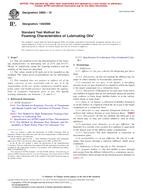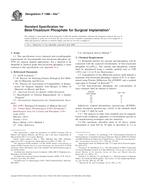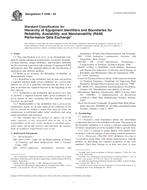1.1 This test method covers the measurement of steady state thermal transmission through flat slab specimens using a heat flow meter apparatus.
1.2 The heat flow meter apparatus is used widely because it is relatively simple in concept, rapid, and applicable to a wide range of test specimens. The precision and bias of the heat flow meter apparatus can be excellent provided calibration is carried out within the range of heat flows expected. This means calibration shall be carried out with similar types of materials, of similar thermal conductances, at similar thicknesses, mean temperatures, and temperature gradients, as expected for the test specimens.
1.3 This a comparative, or secondary, method of measurement since specimens of known thermal transmission properties shall be used to calibrate the apparatus. Properties of the calibration specimens must be traceable to an absolute measurement method. The calibration specimens should be obtained from a recognized national standards laboratory.
1.4 The heat flow meter apparatus establishes steady state one-dimensional heat flux through a test specimen between two parallel plates at constant but different temperatures. By appropriate calibration of the heat flux transducer(s) with calibration standards and by measurement of the plate temperatures and plate separation. Fourier’s law of heat conduction is used to calculate thermal conductivity, and thermal resistivity or thermal resistance and thermal conductance.
1.5 This test method shall be used in conjunction with Practice C 1045. Many advances have been made in thermal technology, both in measurement techniques and in improved understanding of the principles of heat flow through materials. These advances have prompted revisions in the conceptual approaches to the measurement of the thermal transmission properties (1-4). All users of this test method should be aware of these concepts.
1.6 This test method is applicable to the measurement of thermal transmission through a wide range of specimen properties and environmental conditions. The method has been used at ambient conditions of 10 to 40°C with thicknesses up to approximately 250 mm, and with plate temperatures from- 195°C to 540°C at 25-mm thickness (5, 6).
1.7 This test method may be used to characterize material properties, which may or may not be representative of actual conditions of use. Other test methods, such as Test Methods C 236 or C 976 should be used if needed.
1.8 To meet the requirements of this test method the thermal resistance of the test specimen shall be greater than 0.10 m 2K/W in the direction of the heat flow and edge heat losses shall be controlled, using edge insulation, or a guard heater, or both.
1.9 It is not practical in a test method of this type to try to establish details of construction and procedures to cover all contingencies that might offer difficulties to a person without pertinent technical knowledge. Thus users of this test method shall have sufficient knowledge to satisfactorily fulfill their needs. For example, knowledge of heat transfer principles, low level electrical measurements, and general test procedures is required.
1.10 Standardization of this test method is not intended to restrict in any way the future development of improved or new methods or procedures by research workers.
1.11 Since the design of a heat flow meter apparatus is not a simple matter, a procedure for proving the performance of an apparatus is given in Appendix X3.
1.12 This standard does not purport to address all of the safety concerns, if any, associated with its use. It is the responsibility of the user of this standard to consult and establish appropriate safety and health practices and determine the applicability of regulatory limitations prior to use.
Product Details
- Published:
- 09/10/2002
- Number of Pages:
- 14
- File Size:
- 1 file , 170 KB


